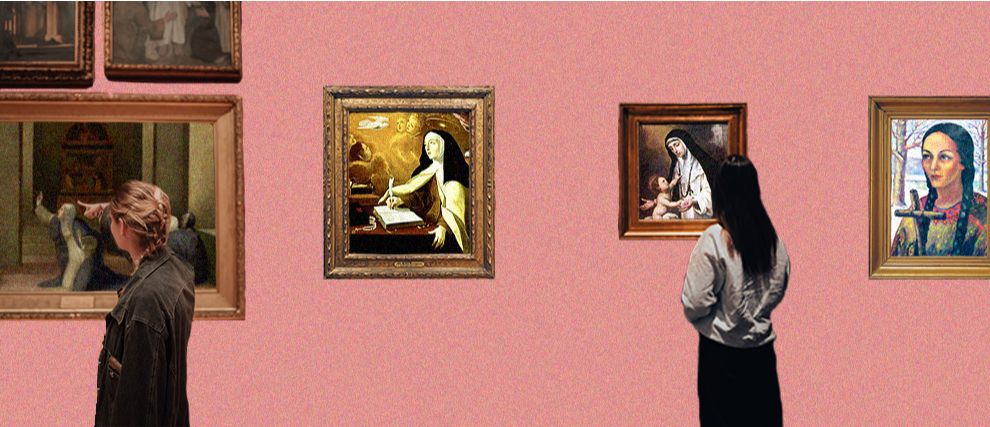Pilgrimages for Mothers
Stopping, taking time to give thanks to the Lord, sharing and entrusting your family, your marriage, your children, and your prayer intentions—these are the common features of all the pilgrimages for mothers. These are very privileged times of encounter and communion with Jesus and his Holy Mother. During these pilgrimages, mothers can seek counsel from the one who said “yes” without doubting or being afraid, and ask for the grace to abandon themselves in love and trust.
Pilgrimage to Cotignac
The most famous pilgrimage for fathers is certainly Cotignac. It was created, in 1976, by a young father whose wife was going through a very difficult pregnancy. The doctors were not optimistic about the baby’s health. The couple therefore decided to go to Cotignac at the end of winter to pray to the Holy Family there. The soon-to-be father promised to return, setting out on foot from Aix-en-Provence, if the delivery went well. A little girl, Emmanuelle, was born in perfect health. Her father decided to keep his promise. He left from Aix with a friend, heading toward Cotignac. The infant and the mother met them at the destination to give thanks with them for their daughter’s birth.
The following year, the father left with another friend. The year after that they were a small group of men setting out, welcomed from 1982 onward by the Community of Saint John, which now manages the sanctuary.
After a few years, seeing their husbands setting out on pilgrimage to Cotignac, several women decided that they too would go and pray to the Holy Family at the end of a pilgrimage—women only—in order to share about their great mission as wives and mothers.
So it is three days of walking, prayer, and sharing, to arrive at Cotignac and entrust all the intentions and thoughts of a mother.
Nearly eighty groups of mothers from the four corners of France converge, each on their own route, toward the sanctuaries of Cotignac. This high point of the year is a rewarding experience, enabling one to share moments of joy and renewal under the kind and maternal gaze of the Blessed Virgin Mary.
The walking (between 15 and 20 kilometers per day) is punctuated by daily Mass, spiritual teachings, times of sung prayer, times of silent walking, and convivial times.
Here is the testimony of a mother after the Cotignac pilgrimage:
“It’s the ‘extraordinary’ experience of leaving one’s habits, one’s comfort (sleeping under the open sky, a quick wash, picnics, no gas, no electricity), of cutting the cords (including the phone) to focus on what is essential: an invitation to live the spirit of poverty.
In the image of the Holy Family, it is a school of life in simplicity, gentleness, charity, and prayer. It is the great school of abandonment and of silence. We come to recharge the batteries, to ask, to give thanks, to take stock, to discern, to be consoled, advised, to draw from the Source, to give time to God, and to carry the intentions entrusted.”
The pilgrimage takes place in the summer.
Pilgrimage to Vézelay
Pilgrimage is an encounter with the Lord, a time to step out of daily life and leave behind one’s habits and comforts, to cut the cords of technology in order to return to what is essential and live the spirit of poverty, sharing, and friendship. It is a school of simplicity and prayer. Mothers take part in these pilgrimages in order to take the time to breathe, to ask for graces, to entrust their husband and children, to ask for the grace of having children, to intercede or to give thanks, but also to listen to the Lord and to his will. It is also an opportunity to take stock, to discern, to be consoled or advised, and to rediscover one’s vocation as a woman, a wife, or a mother. Above all, it is an opportunity to tighten the bond of love with the Father.
Each year, the pilgrimage is open to mothers, to those hoping for children, to grandmothers, and to all women who wish to take part, whatever their age, their faith, or their state in life.
The eighteen-kilometer walk is punctuated by Mass, spiritual teachings, times of prayer, silence, and sharing. On Saturday evening, a vigil of prayer and adoration is organized, and the night is spent under canvas. The pilgrimage generally concludes on Sunday after Mass and a shared meal.
Pilgrimage in Nantes
The first pilgrimage was indeed born in Cotignac. In view of the influx of pilgrims every year and its success, several other holy places also undertook to organize pilgrimages. In general, all these places choose the same date so that all the pilgrims are united in prayer. This is the case in Nantes and its pilgrimage to Notre-Dame du Marillais. History tells that the Blessed Virgin Mary appeared to Saint Maurilius, a disciple of Saint Martin, in 430 (one year before Mary was recognized as the Mother of the Savior at the Council of Ephesus). However, it was only in the 11th century that this Marian apparition appeared in the writings. The Mother of Jesus therefore quite logically has a central place in the beginning of the evangelization of the Anjou region.
This Pontchâteau pilgrimage of wives and mothers is therefore placed under the tender and protective gaze of our Mother, Mary.
The pilgrimage begins near the cathedral of Nantes and ends at Notre-Dame du Marillais, a little over thirty kilometers away. Departure is on Friday in the early evening. Saturday is punctuated by two teachings, prayers, confessions, and spiritual conversations. At the end of the day, there is a Mass and then a night of adoration. The pilgrimage concludes after Mass and a shared meal with the families.
Continue your prayer with Hozana!
Discover wonderful prayer communities with Hozana!
Pray with the and for women hoping for children!

